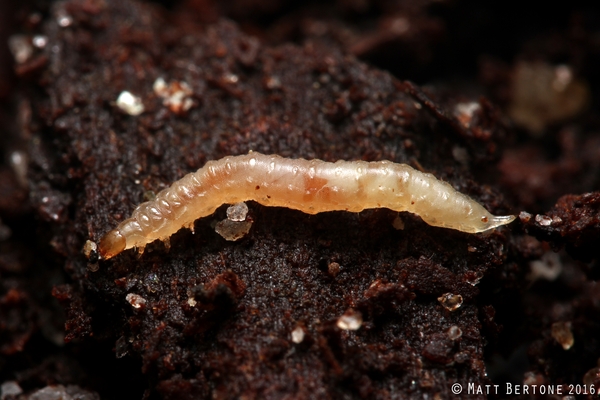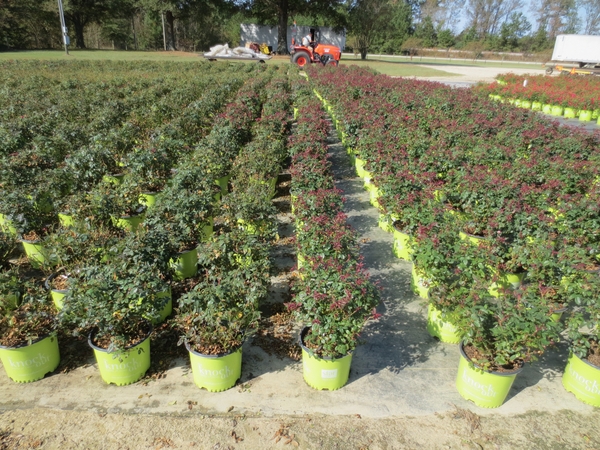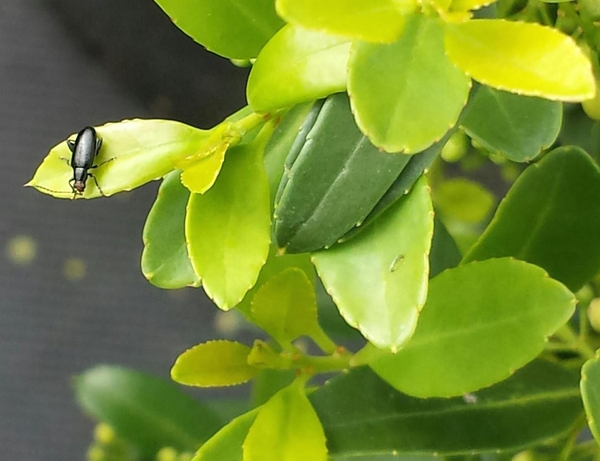Identification and Damage
The red-headed flea beetle (RHFB), Systena frontalis, is a serious pest of broadleaved ornamental plants in nurseries, is native to the Unites States (US), with a distribution from the Rocky Mountains to the East Coast and Southern Canada to Florida and Texas. Growers have identified Hydrangea paniculata, Itea virginica, Weigela florida, Ilex spp., Rosa spp., Rhododendron spp. (azaleas), Osmanthus fragrans, Cornus spp. (shrub and tree form), Sedum spp., and Salvia spp. as the top 10 plant groups most damaged by RHFB. Any broadleaved plant with tender growth when adults are present may be susceptible to injury. Populations seem to build on broadleaved deciduous plants first and, as pressure increases, broadleaved evergreens such as Ilex spp., Osmanthus spp., and Rhododendron spp. can be damaged. Adults eat holes in tender leaves or skeletonize older or thicker leaves making these ornamental plants unsightly and difficult to market for retail sale.
RHFB adults have a shiny black exoskeleton with a reddish to light brown head. They grow up to 0.25 inches (6mm) long and are oval. Antennae are serrate and each segment ranges from light to dark brown. The last set of legs has enlarged femurs adapted for jumping.
Larvae are up to 0.4 inches (10 mm) long and creamy white, have a light brown head, and three pairs of legs near the head. The gut may be visible through the translucent body of larvae. The last segment has a fleshy upward projection with hairs. There are three instars. They feed on roots and have been known to damage cranberry roots in production but don’t seem to have a noticeable effect on ornamental plant roots.
Biology
RHFB overwinters as eggs laid in the fall by the last generation adults. They are oblong, creamy white to pale yellow and slightly less than 1mm long. Eggs are found in container nursery substrate and soil. First generation larvae hatch as early as 250 GDD50 and can be found as late as 800 GDD50. This can occur as early as March or April or as late as mid-May depending on weather and location. Larvae pupate after several weeks of feeding on roots in nursery containers. After pupating, adults begin emerging around 500 GDD50 to 800 GDD50. In some situations, adults are not noticed until over 1000 GDD50. In eastern NC, first generation adult emergence is usually in May or June.
Several generations occur in container nursery production in NC compared to literature references of a single generation per year in soil systems. Second generation adults are usually found in early July around 2000 GDD50 and after this every life stage can be found in nursery substrate (eggs, larvae, pupae) or foliage (adults) through the fall. Adults have been observed as late as the third week of November in eastern NC.
Scouting and Monitoring Larvae
Larvae
Scouting for first generation larvae can begin as early as 250 GDD50 when larvae hatch from overwintered eggs in plants protected in greenhouses or heated or unheated overwintering structures. In plants overwintered outdoors with various covers or not covered at all, larvae may not be found until 400 GDD50. Scouting for larvae involves checking roots of plants known to have been infested the previous year by adults. Scouting should occur on warm days about 30 minutes to 1 hour after irrigation. Remove the root ball from the container and rotate it quickly to check the side and bottom for larvae. Since larvae are sensitive to light, they will move inside the root ball from the edge very quickly. It is helpful to scout on cloudy days or to use your body to shade roots balls. Plants on the south side of blocks may have earlier emergence than those on the north side due to warmer temperatures. Do not scout if root balls are cold to the touch or if dry as larvae will be in the interior under these conditions. Scouting for first generation larvae is key to determining the progression of life cycles at individual nurseries. Thoroughly scout susceptible plant blocks and check root balls of 25 to 50 plants per species or cultivar. There is little need to scout for larvae after the first generation since all stages are present once second-generation adults emerge in early July around 2000 to 2250 GDD50 (in eastern NC) and through fall with overlapping generations.
Scouting and Monitoring Adults
Adults
Adult scouting is much easier. Around 500 to 800 GDD50, start watching for adults jumping and flying around and for feeding injury (holes or skeletonization) on young foliage. If scouting when it is sunny and hot, beetles will be found below the upper sets of leaves shading themselves. Since beetles will jump or fly away with any disturbance (including shadows passing), walk on the down sun side of plants and avoid brushing plants when scouting. Yellow sticky cards placed horizontally over the substrate to catch emerging adults or in a traditional vertical placement just above the foliage are not effective. Growers usually see damage on plants before they find beetles trapped on cards. Sweep netting may be a difficult technique to use since beetles are sensitive to disturbance and it may cause unacceptable plant injury. When fall comes and temperatures are cooler in the morning, beetles will often be found sunning themselves on top of leaves.
Decision Making
Since adult feeding causes unsightly foliage on ornamental plants which results in reduced sales, plant rejections, sales credits, or extended production times to shear, regrow, and protect new foliage, the threshold for this insect and damage is very low for plants going to retail sales markets. Keeping foliar injury below 10% for plants destined for retail sales is ideal. If growing specifically for commercial landscape installation, greater injury may be tolerated. Growers may want to determine if some susceptible species or cultivars are worth growing. Growers might consider not growing species or cultivars with low profitability or low sales that are often heavily damaged. Work with sales and marketing staff to make sure every effort is made to sell smaller container grown shrubs within 1 year of potting. If growers commonly have plants that remain for over a year, consider reducing production numbers. For plants produced for sale at larger sizes (over 3 gallon), a long term, multifaceted management plan is critical to producing quality plants with limited injury for on-time sales.
Intervention and Management - Cultural Management
Before considering insecticide applications, there are some potential production practices that can benefit growers. Close management of propagation, source plants (liners), production numbers, and existing inventory can help lower insect population, pressure, and injury.
Excluding RHFB from propagation areas via enclosed or insect screened production houses can help prevent early population buildup. Communicating with liner sources about their RHFB management can help determine if early steps are needed when plants arrive. In addition, scout plants for larvae and adults upon arrival or at the appropriate time if held on-site before repotting.
Many weeds and native plants that grow in and around nurseries are RHFB hosts. Managing vegetation and scouting nursery perimeters are important steps to determine if significant insect pressure exists outside of nursery production areas or is primarily in production areas. Most pressure usually exists in nursery production areas. However, scouting perimeters may help growers find small numbers of RHFBs that may move in from outside the nursery.
Consider rotating susceptible plant production locations yearly to help avoid population transfer from old crops to those newly potted. Rotating susceptible plants and conifers will help slow population increase since conifers are not RHFB hosts.
Intervention and Management - Biological and Chemical Management
Historically growers have focused on targeting adults since they are the life stage that damages plants. If growers see heavy, repeated years of injury then applying appropriate treatments prior to egg hatch and larvae emergence or after larvae emergence to manage larvae and prevent high adult populations is key to reducing plant injury. Application of systemic insecticides or insect growth regulators that target larvae just after egg hatch should be done prior to 250 GDD50 (before egg hatch). Products containing azadiractin (insect growth regulator), cyantraniliprole (diamide), dinotefuran (neonicotinoid), imidacloprid (neonicotinoid), or thiamethoxam (neonicotinoid) work well when applied as drenches prior to first generation egg hatch (prior to 250 GDD50). Chlorantraniliprole (diamide) may provide control when applied in this manner as well, but has not been tested. Granular products containing imidacloprid can be incorporated into substrate or top-dressed after potting at medium to high rates to provide preventive control for plant species and cultivars that historically have high population and damage.
In order to target larvae after egg hatch, drench applications can be made beginning between approximately 250 GDD50 and 500 GDD50 when larvae are found in root balls via scouting. Options are azadirachtin (insect growth regulator), Beauveria bassiana, Isaria fumosorosea, and Metarhizium anisophilae (entomopathogenic fungi) (these previous products require two applications to provide control at a level similar to one application of the following), Steinernema carpocapsae (entomopathogenic nematode), or insecticides containing acephate (organophosphate), cyantraniliprole (diamide), or spinetoram + sulfoxaflor (spinosyn + sulfoximine). Drenches can be used to manage larvae in stock plants, small groups of plants not sold from the previous year, or liners purchased from other growers if a RHFB problem is known or scouting dictates.
Scout for adults between 500 to 1000 GDD50 and after to determine when to start applications. Foliar applications can be made as needed based on insect pressure. Growers with light pressure may only have to make monthly applications. Intermediate pressure requires applications every two weeks. High pressure without larvae management often requires weekly applications. There are many products that have been shown to reduce RHFB adults when applied as foliar applications. Options include products containing acephate (organophosphate), acetamiprid (neonicotinoid), bifenthrin (pyrethrin), carbaryl (carbamate), chlorantraniliprole (diamide), cyantraniliprole (diamide), cyclaniliprole (diamide), cyclaniliprole + flonicamid (diamide + flonicamid), cyfluthrin (pyrethroid), cyfluthrin + imidacloprid (pyrethroid + neonicotinoid), dinotefuran (neonicotinoid), tau-fluvalinate (pyrethroid)(good in rotation to ensure mite suppression), imidacloprid (neonicotinoid), lambda-cyhalothrin (pyrethroid), sulfoxaflor + spinetoram (sulfoximine + spinosyn), thiamethoxam (neonicotinoid), and tolfenpyrad (mitochondrial electron transport inhibitor). Make sure coverage is thorough. Boom or hand spraying will provide better coverage and population reduction than applications made with air blast sprayers.
No matter what management options you choose, remember to read and follow label instructions. Some products have maximum rates per application, number of applications or maximum rates per year, per acre per year maximums, per growing season maximums, or maximums per generation of insect. Always rotate between classes of insecticides to prevent resistance. Consider your employees and the environment by following all label instructions including personal protective equipment requirements, worker protection standards for re-entry, and precautions for environmental safety.
References and Resources
- Some insects injurious to vegetable crops. Chittenden, F.H. 1902. USDA Entomology Bulletin 33:111-113.
- Current Pest Status and Management Practices for Systena frontalis in Ornamental Plants in Eastern United States: An Online Survey. Joseph, S.V. et al. 2021. Journal of Integrated Pest Management. Volume 12, Issue 1.
- Red-Headed Flea Beetles. Kunkel, B. 2013. SARE Fact Sheet.
- Red-Headed Flea Beetle: An Ornamental Nursery Pest. Joseph, S.V. and Hudson, W. 2020. UGA Circular 1187.
- Don’t Get Fooled by the Flea Beetle. Cloyd, R. and Herrick, N. 2018. Nursery Management, September.
- Life History and Damage by Systena frontalis on Vaccinium macrocarpon. Jaffe, B. et. al. 2021. Journal of Insect Science. Volume 21. Issue 1.
- Red-Headed Flea Beetle Management in Container Nursery Production. Lauderdale, D. 2022. NC State University.
- Incorporating Granular Imidacloprid to Reduce Red-Headed Flea Beetle Injury. Lauderdale, D. 2021. NC State University.
- Topdressing Granular Imidacloprid to Reduce Red-Headed Flea Beetle Injury. Lauderdale, D. 2021. NC State University.
- How to Handle the Red-headed Flea Beetle. Lauderdale. D. 2021. Nursery Management. September.
- IR-4 Environmental Horticulture Program Management of Borers, Beetles, and White Grubs: Redhaded (Cranberry) Flea Beetle (Systena frontalis). Palmer, C. and Vea, E. 2022. The IR-4 Project. Environmental Horticulture Research Summaries.
For assistance with a specific problem, contact your local Cooperative Extension center.
Publication date: Dec. 21, 2022
N.C. Cooperative Extension prohibits discrimination and harassment regardless of age, color, disability, family and marital status, gender identity, national origin, political beliefs, race, religion, sex (including pregnancy), sexual orientation and veteran status.
Recommendations for the use of agricultural chemicals are included in this publication as a convenience to the reader. The use of brand names and any mention or listing of commercial products or services in this publication does not imply endorsement by NC State University or N.C. A&T State University nor discrimination against similar products or services not mentioned. Individuals who use agricultural chemicals are responsible for ensuring that the intended use complies with current regulations and conforms to the product label. Be sure to obtain current information about usage regulations and examine a current product label before applying any chemical. For assistance, contact your local N.C. Cooperative Extension county center.
N.C. Cooperative Extension prohibits discrimination and harassment regardless of age, color, disability, family and marital status, gender identity, national origin, political beliefs, race, religion, sex (including pregnancy), sexual orientation and veteran status.





















